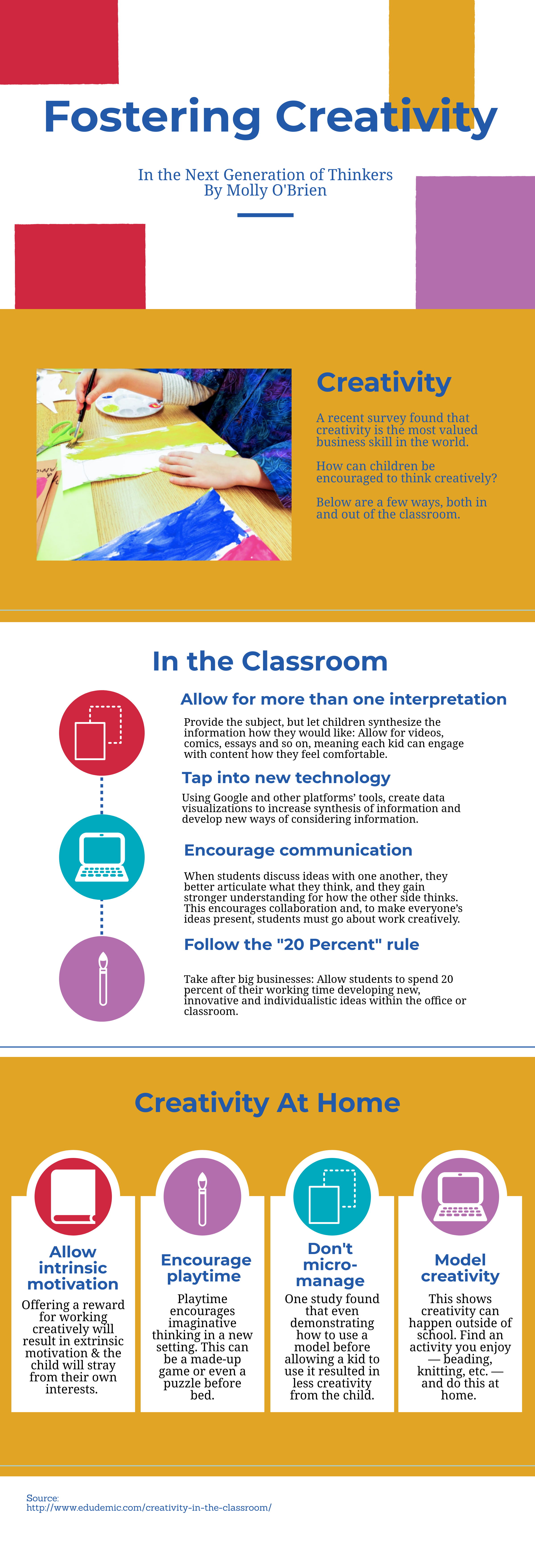A canvas for child development
Twenty or so kids gather next to Keegan Lynch, hanging on his every word. He reads them a story to spur their creativity, and the students are set loose to work.
It’s art class.
Pressing hard with a hot pink Crayola colored pencil, a second-grader focuses intently on his paper. Sharpie marks outline misshapen circles collaged with a vibrant background to create a pink, blue and green explosion. Taking a step back, he announces he is done.
“This is a sea lion, and right there is a meteor coming toward him, and he needs to escape it,” he tells his classmate, pointing to a brown blob, followed by a circle the size of a small fist slightly resembling a beach ball. “But then there’s also the bad sea lion coming after him, and he has to swim away from that. He’ll make it, though.”
Lynch nods. As a first-year art educator at Van Hise Elementary in Madison, he encourages self-expression from his students.
Lynch is creative himself; he plays drums in a band, does graphic design work for friends and organizes concerts in fellow musicians’ basements in his free time. And with his students, Lynch stimulates conversation about their lives outside of class, knowing everyone sees the world through a different lens.
Schools often allocate funding to core subjects such as math, reading and science, but when budget cuts happen, arts can be a quick target. This means less personalized attention and fewer supplies in the art classroom — a space integral to wholesome childhood development. In art class, students take time to explore their interests and express themselves, providing comfort in a setting that can sometimes cause stress. Developing creative thought processes can possibly promote innovative thinking in core subjects as well.
“No matter what I was interested in at the time, it had a place in art,” says Mary Hoefferle, the undergraduate art education program director at UW–Madison. “So if I was really interested in architecture and houses and architectural history, then I could explore that in art. If I was interested in understanding how I was similar or different than the rest of my family, I could explore that question in my artwork.”
Creative thinkers such as Hoefferle and Lynch see value in keeping art programs alive.
While the boy coloring with the hot pink colored pencil was one of many students assigned the same project in Lynch’s class, he was the only one to transform a few ambiguous circles into sea lions. Other students decorated their papers with donuts, pizzas, monsters and other imaginative creations.
These kinds of projects give elementary students time to explore their own interests in a creative environment. Lynch’s class shows that everyone has their own unique perspective to share, even if they start from the same guidelines.
Similarly, Lynch starts his fifth grade art class with an activity called blind contour portraits, where students only look at the face of someone near them and draw what they see. The result is 20 or so muddles of lines and colors, none of which really resemble a portrait. The class-identified “artist” has a paper as messy as the girl who prefers multiplication tables rather than coloring.
“I don’t want them to feel super pressured to create anything amazing. I want them to be able to take ownership of whatever they do,” Lynch says. “If you can kind of get them to create something that’s sort of cool looking right away, that’s a huge confidence boost for the kids that have lower self-esteem in the class.”
Elementary school crucially shapes children’s self-esteem. Children typically act as independent for the first time while in elementary school, and the power of institutions becomes present, according to Professor Erica Halverson of the UW–Madison Department of Curriculum and Instruction.

Halverson says that showing what a child can offer in comparison to their classmates evokes a sense of pride in this new setting.
“When kids are sharing what they already know, they feel like they are contributing positively to the learning environment,” Halverson says. “And creative expression, which often starts with your own ideas, your own perspectives, your own joys, your own sadnesses … immediately puts kids in the driver’s seat.”
The National Coalition for Core Arts Standards outlines the major foundations and lifelong goals of artistic literacy. One of these facets is the arts as communication, specifically in a multimedia world. Using artistic creations and imagery as a language can enhance a person’s life as it improves capabilities to communicate with individuals they otherwise may not.
Students use art projects to articulate ideas they otherwise may not express, especially in younger age groups. Hoefferle says pictures are children’s first language. Before children can write, they use images to depict their families, their homes and their understanding of the world. Like the boy with his sea lions, the work young people create expresses the knowledge bouncing around in their brains.
After creating masterpieces, kids further their self-exploration as they talk about their art using details more vivid than their favorite bedtime story.
In Lynch’s room, the students gather in a circle on the floor surrounded by white boards, bookshelves and abstract art. The physical piece of paper in front of them provides a chance to explain their own perspective of the world — where one child sees farmland, another sees a hurricane.
Students discuss their drawings, picking out hidden gems, such as Pokémon or the colors of cotton candy, to identify parts of their work. Then they take turns critiquing one another’s projects. This process allows the students to constructively interact with each other — a skill valued by parents and an opportunity other subject areas may not offer.

“Across all art forms, one of the main values and outcomes that we don’t see in other academic disciplines is the role of audience,” Halverson says. “So, even if an artist is kind of creating in a solo environment, as artists and as teachers of the arts, we are almost always encouraging people to share the work they make with external audiences not to get validation of, ‘Oh, you did a good job,’ but to get feedback and to share that part of themselves in a public way.”
When the picture is hung on the fridge, the impact becomes much greater than a kitchen decoration.
Nationally, funding cuts often bring art class to the chopping block, since it is not a core subject. This can result in fewer art supplies and less class time. Or no arts or music programs whatsoever.
It happens in Wisconsin, too.
Hoefferle remembers one former student who was teaching in northern Wisconsin. The woman’s schedule had her teaching in multiple schools with classes scheduled back-to-back. With a jam-packed schedule and hundreds of students, the teacher is spread thin and unable to provide the care and attention students need.
“Her teaching schedule told you [indirectly] how little that district valued art,” Hoefferle says. “She taught in three different schools …What kind of quality are you going to get out of that? I was so disgusted on her behalf.” Hoefferle also notes the art classroom budget was based on $2 per student.
The tendency to undervalue art may stem from a poor history of art education in people who are now adults. Ten years ago, the Madison Children’s Museum conducted listening sessions to learn more about art in the Madison community. Kia Karlen, the museum’s director of education, discovered many adults had been told or personally thought they were not good at art at some point in their lives, leading to a dislike for the subject in general.
Some people view art as a place to do simple crafts in which they just follow instructions — something Hoefferle calls “instant art” — and this can cause a negative expereience. This is what she believes many adults remember about art class growing up, and, as a result, why the subject may be undervalued.
Currently, Lynch says he’s seeing a void of creativity, which he believes may have something to do with the digital age. Technology moves fast, information is readily available and kids no longer have to create their own fun. The average age for receiving a smartphone is 10.3 years old, and half of kids are connected to social media by the age of 12, according to the 2016 Digital Trends Study by Influence Central research agency.
“Kids are doing less stuff with their own heads, like out and about,” Lynch says. “I’ve kind of had this philosophy the past few years that I want to reinstate or introduce them to these cool aspects of the world that maybe they’re not getting otherwise, and art is just my vehicle for doing this.”
Links across subject matter provide strong understanding that may not exist without hands-on experience. Lynch always starts his class by reading a story related to the project. On this day, the story was of a bear creating abstract art. Others did not see anything specific in his work, but when the bear flipped his canvas upside down, a self-portrait emerged. The book showcased the bear’s unique perspective, reflective of what the students were learning.
“I usually try to tie in a little bit of literacy, science — or sometimes, weirdly, even history or math — into these things. Because that’s what I learned is really good practice, and that’s what keeps your art department alive,” Lynch says.
As the second graders finish up their abstract art, one student asks her friend how many faces she can find in the illustration. Her friend cocks her head to the side and guesses three. She’s close, but when the little girl rotates the paper, there’s a fourth one hiding.


